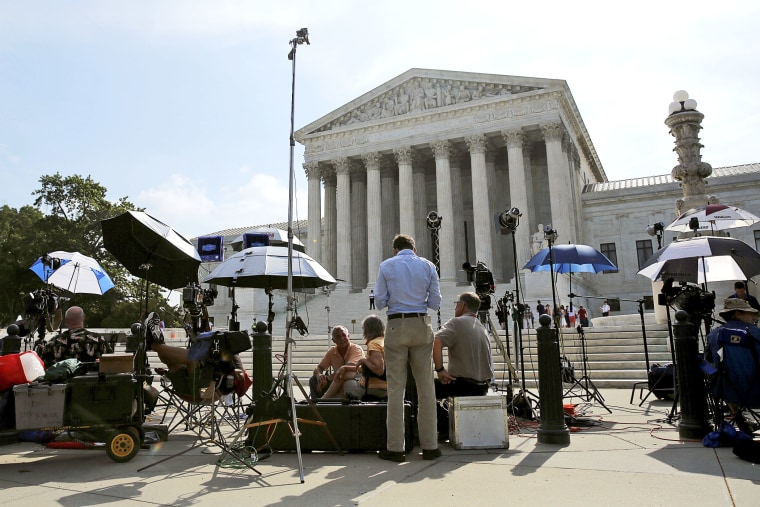Most of the time, litigation in federal court is pretty straightforward: Someone sues someone else; one side wins; the other side appeals. Done and done.
Not so with the battle raging over Obamacare’s subsidies. In the wake of yesterday’s dueling court rulings, that fight -- one with massive implications for the law’s future -- has descended into an unusually complex legal chess match.
The next move: Look for Obamacare’s challengers to run to the Supreme Court and ask it to hear the case now. The Obama administration, meanwhile, will be pressing the fight in a lower court and doing everything it can to stay out of the high court altogether.
Obamacare’s future may depend on how willing the Supreme Court is to step in.
* * *
Yesterday’s rulings are about a key piece of the Affordable Care Act: the tax credits, or “subsidies,” the law provides to lower-income Americans who buy insurance through health exchanges. Those subsidies dramatically reduce the cost of insurance, making coverage possible for millions who otherwise couldn’t afford it.
In New Jersey, for example, the average “sticker price” for a monthly premium is $465, or more than $5,000 per year -- out of reach for those at the bottom of the income bracket. But most people who have signed up through Obamacare qualified for a subsidy -- $317, on average -- making the consumer’s cost just $148 a month.
Without those subsidies, many new customers would not sign up. And without an influx of healthy new customers, the insurance market could face what health analysts call the “death spiral”: Only people who are already sick (and expensive to cover) would find health insurance to be a good deal and sign on, which would raise insurers’ average costs, which would lead to a big hike in premiums, which would push more healthy customers out of the market, and so on.
That’s what makes yesterday’s rulings so important: If the law’s challengers prevail, subsidies will be unavailable in 36 states.
The issue comes down to four words in the Affordable Care Act. When Congress drafted the statute’s tax-subsidy section, it wrote that insurance applicants are eligible for subsidies if they enroll through an exchange “established by the State.” But after the statute was enacted, 36 states refused to set up exchanges, so the federal government did it for them.
Obamacare opponents have argued that in those 36 states, there is no exchange “established by the state” and thus those states’ residents can’t get subsidies. The administration has taken a different tack: In a ruling last year, the IRS concluded that federally-established exchanges stand in the shoes of state-established exchanges, and it made subsidies available nationwide. Obamacare opponents quickly challenged the IRS decision as unlawful -- in direct conflict with what Congress wrote.
That fight has been raging before a pair of federal appeals courts: the D.C. Circuit in Washington, D.C., and the Fourth Circuit in Richmond, Virginia. Yesterday, in a wild turn of events, both courts handed down their long-awaited rulings within hours. In the first ruling, a three-judge panel of the D.C. Circuit sided with the challengers and ruled that the government cannot provide subsidies in 36 states. Soon after, a three-judge panel of the Fourth Circuit came out the other way, siding with the IRS and ruling that, read in context, the statute authorizes subsidies nationwide.
So what happens next?
The government has already said what it will do: ask the full, 11-judge D.C. Circuit to rehear the case. The majority of those 11 judges were appointed by Democratic presidents, and so far, every judge to weigh in on the subsidies has voted along party lines. The administration thus has a decent chance of flipping the D.C. Circuit result.
It is hoping, no doubt, that the case will end there. If both the D.C. Circuit and the Fourth Circuit end up siding with the government, and no court disagrees, then the best reason for Supreme Court review -- a disagreement among the lower courts -- disappears.
The challengers, however, know that’s the government’s best play. That’s exactly why their next move is likely to run straight to the Supreme Court. They’ll appeal from the Fourth Circuit decision and ask the high court to take the case now and resolve the current split between the two appeals-court decisions.
The government presumably will oppose that move, telling the Supreme Court to sit tight until the D.C. Circuit is finished. But the Supreme Court could decide to take the case now anyway.
And if it does, watch out: The high court’s five conservatives may well be sympathetic to the challengers’ argument that the statute’s key words -- “established by the State” -- mean exactly what they say. Chief Justice Roberts, in particular, could adopt that position without contradicting what he said in the first blockbuster Obamacare litigation.
The government’s best shot, in short, is to bar the door to the Supreme Court. Obamacare’s future hangs in the balance.
Dominic Perella is a partner in the law firm of Hogan Lovells, where he specializes in Supreme Court and appellate litigation.
